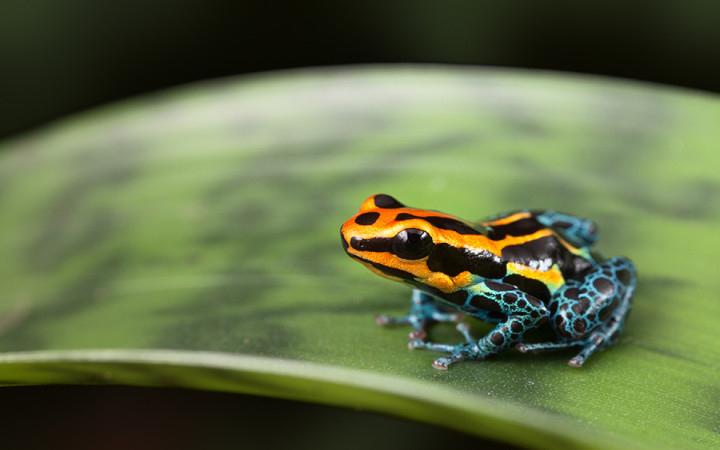Today’s Wonder of the Day was inspired by Ethan. Ethan Wonders, “Do you know anything about tree frogs?” Thanks for WONDERing with us, Ethan!
Imagine you're trekking through the dense rainforest of South America. Along the way, you gaze up at the gigantic trees in amazement. Later, you crouch down to get a better look at some bugs. A flash of color catches your eye and you realize it's a poison dart frog.
You're tempted to get a closer look at this amphibian but you WONDER, are poison dart frogs really that poisonous? In this Wonder of the Day, let's find out!
There are many species that make up the family of poison frogs native to Central and South America. These tiny frogs tend to live amongst the leaves on the rainforest floor near ponds or streams, although a few species live in the trees and never come down.
Poison frogs are known for their bright, vivid colors. You can find them in just about any color combination you can think of. The colors you're likely to see include red, black, yellow, green, blue, gold, copper, orange, silver, and pink.
These flashy colors make poison frogs stand out, but they don't make them easy prey. Instead, their coloring is a defense mechanism that protects them from predators. Their bright colors serve as a warning that their skin is poisonous, so it's best not to eat them. In order to be easily seen by potential predators, poison frogs are diurnal, which means they're mainly active during the day.
Exactly how poisonous are poison frogs? That can be hard to determine. Some species are not toxic at all. Most poison frog species are considered toxic but not deadly. The poison in their skin can cause swelling, nausea, and paralysis if touched or eaten without necessarily being fatal.
A few species, however, are considered to be among the deadliest animals on Earth. For example, the golden poison dart frog has especially toxic skin with enough poison to kill as many as 10 grown men.
The indigenous peoples of Colombia are known to dip the tips of their blowgun darts in this powerful poison when hunting. This practice is what gives poison dart frogs their popular name.
Each poison frog species develops a unique kind of toxin, and scientists believe the poisons come from the frogs' diet, which can include various rainforest insects such as ants, beetles, centipedes, and termites. This is why poison frogs kept in zoos or bred in captivity are not toxic. Without the unique diet provided by rainforest insects, these frogs never develop the toxic poisons.
Although toxic to humans and animals, frog poisons may soon provide medicinal benefits to humans. Scientists researching frog poisons believe they can be modified and turned into medicines to treat pain and heart and circulatory conditions.





